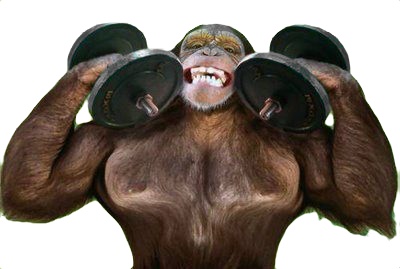THIS COULD CHANGE THE WORLD
Two monkeys walk into a lab. They lift weights. They get really strong. How strong?
I've said it before and I'll keep saying it, because it's the truth: changes in your strength are all about changes in your nervous system, not changes in the size or strength of your muscle fibers.
Here's more proof:
A recent New York Times article titled "How We Get Stronger" explored the findings of Drs. Glover and Baker published in the Journal of Neuroscience. Their paper titled "Cortical, Corticospinal and Reticulospinal Contributions to Strength Training" is the first report of a strength training intervention in non-human primates and gives us even more insight into what is really happening within our nerves when we lift weights.
This study is unbelievably significant!
So let's get to the good stuff. Stay with me while I quickly set the table with a few key details:
You've got two main bundles of nerves that descend from your brain and direct movement: the corticospinal tract (CST) and the reticulospinal tract (RST).
In evolutionary terms, the RST is ancient. It arises from the more primitive areas of the brain. It is common in lower tier species such as reptiles. These nerves direct broad preparatory and movement related activity and postural control.
The CST is younger in evolutionary terms and more refined. It controls fine motor skills. It's found in monkeys and humans, but rarely in reptiles.
With tiny transmitters and electrodes implanted, the researchers tracked how each set of nerves responded and changed as the animals lifted with their right arm only. The monkeys trained 5 times a week for 3 months, increasing the weight load until they could complete the equivalent of "a human doing 50 one-armed pull-ups," said lead author Isabel Glover.
What drove this impressive gain in strength?
Answer: Progressively stronger and more urgent nerve commands to the muscles. But those messages came from, and strengthened only one set of nerves - the more primitive RST.
What does this mean?
First, as you will soon learn, the tract of nerves strengthened is significant. We never knew this before.
Second, "Strength isn't just about muscle mass," said Dr. Glover. "You get stronger because the neural input to your muscles increases."
See, I told you so.
So you still think you're making your muscles stronger when you lift those weights?
Think again.
You're really strengthening your nervous system, literally.
The key to all of this?
Load.
Here's why the tract of nerves involved is significant. The RST is bilateral and has the largest density of projections to the trunk and proximal limb (thigh and upper arm) muscles on both sides of the body, often engaging the upper and lower limbs at the same time.
It is the integrator of whole body movement.
Even though the monkeys only lifted with their right arms, their spinal circuits adapted to demonstrate a greater output even on their left side. Significant changes occurred in both the gray and white matter of the spinal cord on both the right and left side, with the trained side showing a greater effect.
The highest load lifted led to the greatest activation of all muscles in the right arm. But the really cool thing is, the same thing happened in the left arm that did nothing. The lighter loads lifted didn't have any effect on the immobilized left arm.
Get it?
Load is the key!
-
Not fatigue
-
Not time
-
Not metabolic stress
LOAD! LOAD! LOAD!
So what's the bottom line?
With increasing loads, the brain (both higher and lower functioning areas) improved connectivity and efficiency of those connections to send information more quickly and strongly down the spinal cord, where spinal circuits got information out to the limbs more quickly and strongly, so more force could be generated by the muscles.
There was, however, one other interesting thing to note. Based on the locations of changes measured within the nervous system, the authors did not see any evidence that changes in motorneurons outside the spinal cord, i.e., the nerves that activate muscle (motor units), played any role in the ability to lift more weight.
Understand? The magic happens in a primitive area of the central nervous system much further upstream from the muscles.
Yet, we put our focus on muscle, while the changes that actually matter are within the brain and spinal cord.
With the viiiv you can experience the highest of loads safely and leverage the function of the RST to maximize physical fitness results with just a few seconds of time invested. This is why just 5 seconds of maximum effort on one exercise can strengthen your entire body and change your physical fitness overnight! (See my previous article titled The New Minimum Effective Dose, which details results of a study I did supporting this claim.)
So here's the deal:
Load is most important.
When you hop on the viiiv and give it everything you've got for 5 seconds, you will trigger the greatest improvement in the connectivity, strength, and efficiency of your nervous system.
-
The greater the improvement in the efficiency of the nervous system, the less your muscles need to be activated to do anything below a maximum effort, which is almost everything you do every day.
-
The less your muscles need to be activated to do the same given workload, the wider your comfort zone for any effort level becomes so you can do more, for a longer period of time. Your "gas mileage" improves at all effort levels.
The best part is you can get these results with just a few seconds of effort once in a while, and keep these results for a very long time.
You can workout less, play more, and your physical fitness will be great all the time.
Can you see the implications of this information?
Yeah, the viiiv way could change the world, if the world will let it.
